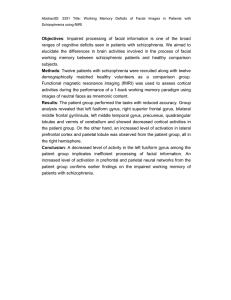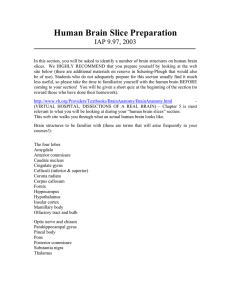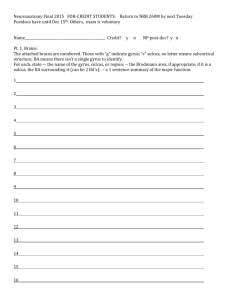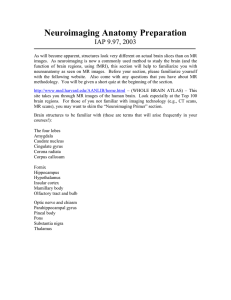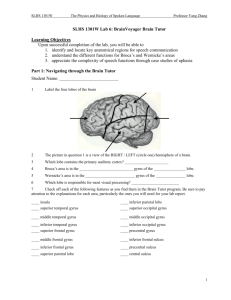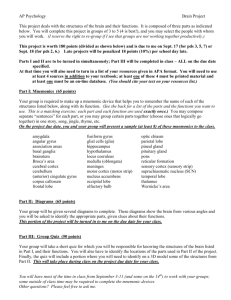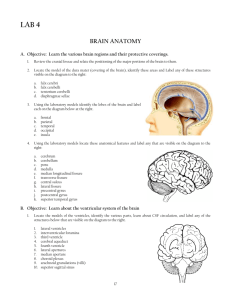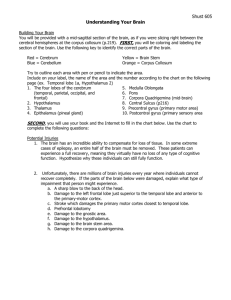Supplementary Materials for Robert P. Spunt,
advertisement
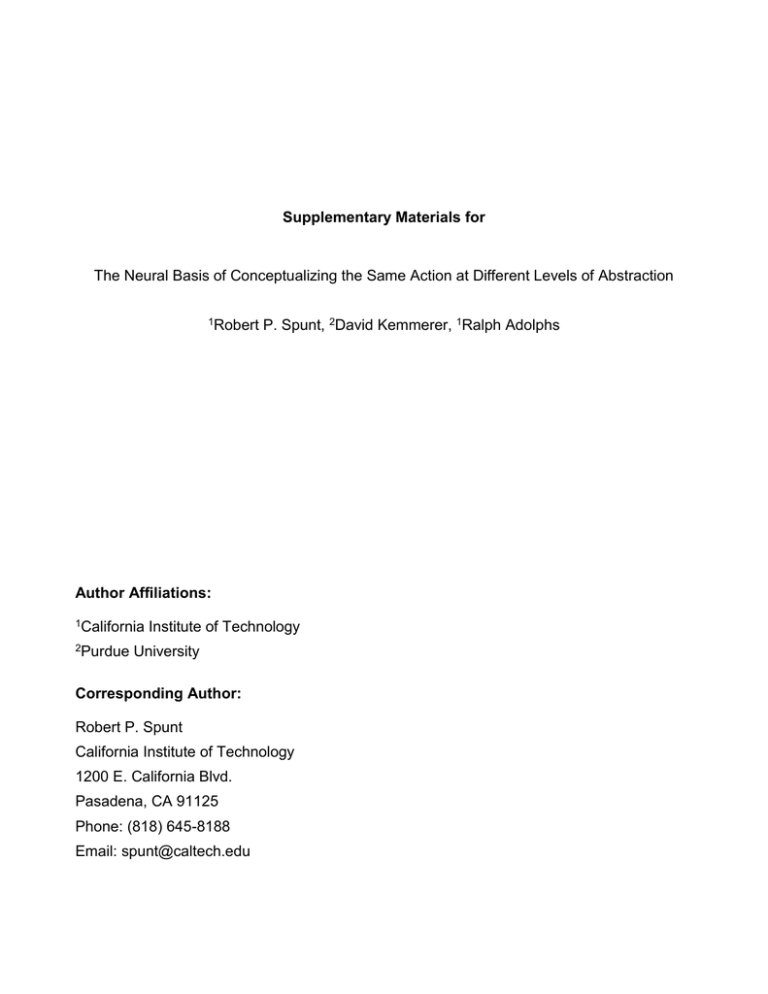
Supplementary Materials for The Neural Basis of Conceptualizing the Same Action at Different Levels of Abstraction 1Robert P. Spunt, 2David Kemmerer, 1Ralph Adolphs Author Affiliations: 1California 2Purdue Institute of Technology University Corresponding Author: Robert P. Spunt California Institute of Technology 1200 E. California Blvd. Pasadena, CA 91125 Phone: (818) 645-8188 Email: spunt@caltech.edu Supplementary Methods Sample Size Determination A power analysis of the Why > How contrast from Study 3 of Spunt and Adolphs (2014) indicated the present study's sample size was sufficiently large to test our primary hypotheses. We based our power analysis on that study because it was conducted using the same scanner, sequence, and preprocessing pipeline as those used in the present study. The power analysis was performed using the open-source software fmripower (http://mumford.fmripower.org/) operating in MATLAB (version 2014b; MathWorks Inc., Natick, MA, USA). Across the 10 regions used in the region-of-interest anlayses reported in the main text (see Figure 2 in main text and Table S2 below for ROI details), 90% detection power for the Why > How contrast required an average of only 8.90 subjects (SD = 3.84, Maximum = 15). Page 2 Table S1 Action phrases included in the study listed in the order of increasing Level of Abstraction (LOA). To facilitate comparability, all semantic dimensions (columns 1-6) have been rescaled to 0 – 1. Phrase NonLOA Abstract imageable Broad N N Mind Arousing Chars Words Freq turn a doorknob click a mouse grab a pencil crack eggs clap hands raise a hand fasten seatbelt brush one's hair cut paper take aspirin wash one's hands open a bottle drink coffee use a comb sign one's name use scissors throw away trash open a magazine lift weights go jogging clip coupons drink wine lift a glass use a remote press buttons point a camera write a check use a brush wear ties stir ingredients use chalk enter a classroom open a browser dial numbers take pills pack a bag consume alcohol make a phone call use a camera give applause take a picture consume medicine consume caffeine mix a cocktail play piano make breakfast use credit cards serve alcohol watch television dress formally write an email 0.00 0.02 0.03 0.04 0.04 0.05 0.05 0.05 0.07 0.07 0.07 0.07 0.07 0.08 0.08 0.08 0.08 0.09 0.09 0.10 0.10 0.10 0.11 0.11 0.12 0.12 0.12 0.12 0.13 0.13 0.13 0.13 0.14 0.14 0.15 0.17 0.17 0.19 0.20 0.20 0.20 0.20 0.21 0.21 0.22 0.22 0.23 0.23 0.27 0.27 0.28 0.00 0.08 0.05 0.06 0.03 0.03 0.08 0.05 0.08 0.14 0.06 0.05 0.09 0.06 0.15 0.10 0.06 0.06 0.00 0.04 0.13 0.15 0.03 0.14 0.07 0.14 0.22 0.08 0.07 0.07 0.12 0.07 0.20 0.14 0.12 0.18 0.18 0.35 0.27 0.14 0.27 0.16 0.13 0.17 0.40 0.20 0.29 0.15 0.52 0.19 0.53 0.00 0.00 0.02 0.02 0.00 0.04 0.01 0.03 0.04 0.03 0.07 0.04 0.03 0.03 0.06 0.04 0.06 0.05 0.04 0.08 0.04 0.04 0.02 0.08 0.05 0.09 0.06 0.08 0.06 0.07 0.08 0.10 0.10 0.09 0.08 0.10 0.08 0.12 0.11 0.19 0.14 0.12 0.14 0.09 0.11 0.12 0.14 0.13 0.17 0.22 0.16 0.01 0.02 0.04 0.00 0.01 0.02 0.02 0.05 0.05 0.05 0.04 0.04 0.02 0.05 0.04 0.06 0.04 0.06 0.07 0.08 0.05 0.05 0.05 0.04 0.08 0.08 0.04 0.06 0.16 0.09 0.06 0.10 0.08 0.06 0.08 0.11 0.14 0.06 0.09 0.09 0.06 0.15 0.27 0.19 0.12 0.12 0.12 0.22 0.04 0.20 0.15 Page 3 0.00 0.01 0.02 0.04 0.03 0.06 0.01 0.05 0.10 0.03 0.04 0.14 0.08 0.15 0.05 0.14 0.11 0.15 0.18 0.10 0.14 0.10 0.30 0.16 0.25 0.12 0.14 0.24 0.20 0.25 0.24 0.22 0.13 0.25 0.26 0.28 0.22 0.18 0.24 0.21 0.24 0.34 0.28 0.36 0.16 0.36 0.29 0.39 0.23 0.37 0.23 0.00 0.05 0.01 0.13 0.45 0.13 0.36 0.13 0.03 0.16 0.32 0.11 0.35 0.09 0.06 0.04 0.30 0.16 0.45 0.47 0.20 0.36 0.12 0.04 0.06 0.19 0.18 0.12 0.18 0.16 0.08 0.16 0.09 0.03 0.29 0.14 0.42 0.16 0.26 0.67 0.34 0.31 0.29 0.37 0.46 0.42 0.37 0.27 0.32 0.35 0.11 13 11 11 9 9 10 14 14 8 11 14 11 11 8 13 11 14 13 11 9 11 9 10 10 12 12 11 9 8 15 8 15 12 11 9 8 14 14 10 12 12 15 15 12 9 13 14 12 15 13 12 3 3 3 2 2 3 2 3 2 2 3 3 2 3 3 2 3 3 2 2 2 2 3 3 2 3 3 3 2 2 2 3 3 2 2 3 2 4 3 2 3 2 2 3 2 2 3 2 2 2 3 2.99 2.62 3.12 3.09 3.16 3.76 1.96 3.25 3.87 3.79 3.66 3.72 3.83 3.18 4.02 3.36 3.74 3.64 2.57 3.52 2.05 3.64 3.25 3.52 2.83 3.24 3.65 3.39 3.11 2.21 3.22 2.77 2.52 2.91 4.04 3.38 2.48 4.30 3.82 3.77 4.40 2.63 2.10 2.73 3.63 4.18 3.64 3.10 3.70 2.54 2.88 prepare meals go shopping make a list paint a picture build muscles attend a school make a purchase ingest nutrients provide food follow recipes hold a party read articles arrive on time kill germs contact a friend send a message make a donation satisfy hunger give a lecture write a poem give to charity get fit teach a class write a song participate in class get a job show cleanliness finish a job get a degree make art help a person save money get a promotion live a long life obey laws entertain others teach others reduce pain make a friend avoid diseases seek advice support a cause show an ability stay alert express a talent show courtesy show appreciation entertain oneself express doubt satisfy a need impress others plan ahead feel well pass the time show competence show humility share ideas avoid mistakes express an idea spread joy 0.29 0.32 0.33 0.34 0.34 0.35 0.37 0.38 0.41 0.42 0.43 0.43 0.45 0.45 0.45 0.46 0.47 0.48 0.48 0.49 0.50 0.51 0.52 0.52 0.53 0.54 0.57 0.58 0.61 0.64 0.65 0.66 0.66 0.67 0.69 0.72 0.73 0.73 0.73 0.75 0.76 0.77 0.77 0.77 0.78 0.79 0.81 0.82 0.84 0.85 0.85 0.85 0.86 0.86 0.87 0.87 0.88 0.89 0.89 0.90 0.13 0.24 0.18 0.22 0.24 0.26 0.23 0.26 0.26 0.33 0.33 0.28 0.42 0.39 0.35 0.38 0.34 0.47 0.36 0.35 0.36 0.44 0.42 0.36 0.45 0.41 0.55 0.46 0.40 0.55 0.57 0.52 0.53 0.63 0.63 0.71 0.66 0.68 0.70 0.71 0.72 0.71 0.70 0.76 0.74 0.80 0.82 0.75 0.84 0.82 0.85 0.78 0.87 0.88 0.84 0.84 0.85 0.83 0.88 0.87 0.24 0.23 0.17 0.19 0.47 0.27 0.22 0.60 0.40 0.30 0.35 0.20 0.53 0.62 0.36 0.31 0.36 0.40 0.38 0.39 0.51 0.52 0.36 0.48 0.37 0.58 0.58 0.68 0.59 0.39 0.56 0.65 0.77 0.81 0.73 0.56 0.54 0.87 0.73 0.99 0.67 0.73 0.74 0.71 0.71 0.62 0.62 0.70 0.74 0.83 0.85 0.76 0.76 0.85 0.85 0.81 0.74 0.99 0.74 0.78 Page 4 0.50 0.47 0.39 0.39 0.53 0.38 0.61 0.57 0.59 0.41 0.47 0.42 0.27 0.50 0.40 0.59 0.48 0.56 0.46 0.38 0.47 0.72 0.50 0.41 0.51 0.53 0.64 0.62 0.60 0.85 0.77 0.55 0.50 0.63 0.58 0.81 0.77 0.74 0.62 0.77 0.75 0.74 0.91 0.68 0.90 0.75 0.81 0.96 0.76 0.96 0.89 0.76 0.87 0.99 0.82 0.81 0.85 0.83 0.88 0.95 0.25 0.25 0.52 0.44 0.03 0.40 0.35 0.06 0.26 0.56 0.41 0.75 0.41 0.19 0.51 0.48 0.51 0.29 0.66 0.74 0.53 0.17 0.64 0.73 0.64 0.51 0.35 0.43 0.71 0.55 0.47 0.71 0.67 0.41 0.69 0.54 0.70 0.46 0.63 0.40 0.76 0.68 0.52 0.76 0.54 0.69 0.67 0.68 0.82 0.56 0.59 0.90 0.65 0.60 0.71 0.81 0.81 0.74 0.80 0.68 0.36 0.42 0.20 0.50 0.65 0.41 0.27 0.37 0.62 0.27 0.61 0.19 0.68 0.49 0.66 0.15 0.73 0.70 0.26 0.47 0.76 0.84 0.45 0.51 0.40 0.71 0.60 0.75 0.84 0.67 0.92 0.86 0.98 0.95 0.40 0.64 0.69 0.62 0.85 0.58 0.25 0.71 0.64 0.44 0.71 0.79 0.82 0.58 0.42 0.64 0.56 0.57 0.87 0.14 0.77 0.57 0.65 0.53 0.62 0.95 12 10 9 13 12 13 13 15 11 13 10 12 12 9 14 12 13 13 12 10 13 6 11 10 18 7 15 10 10 7 11 9 13 13 8 15 11 10 11 13 10 13 13 9 14 12 16 16 12 12 13 9 8 11 14 12 10 13 13 9 2 2 3 3 2 3 3 2 2 2 3 2 3 2 3 3 3 2 3 3 3 2 3 3 3 3 2 3 3 2 3 2 3 4 2 2 2 2 3 2 2 3 3 2 3 2 2 2 2 3 2 2 2 3 2 2 2 2 3 2 2.92 4.09 4.22 3.41 2.98 3.54 3.54 1.47 3.42 2.93 4.19 3.29 3.99 3.25 3.71 3.82 3.55 2.46 3.69 3.33 3.85 4.16 3.67 3.74 3.06 4.85 2.85 3.98 4.12 4.19 4.31 4.21 4.06 4.32 2.80 3.10 3.64 3.02 4.59 2.69 3.18 3.60 3.59 3.19 2.93 3.41 3.31 2.27 2.88 2.99 3.21 2.14 3.85 4.30 2.92 3.14 3.36 3.07 3.50 3.08 spread knowledge show creativity avoid boredom achieve success feel sociable show ambition show intelligence feel productive improve oneself gain knowledge keep a memory show intellect reduce worry feel nostalgia feel secure feel connected increase wisdom 0.90 0.91 0.91 0.92 0.92 0.92 0.93 0.93 0.93 0.94 0.94 0.96 0.96 0.96 0.97 0.99 1.00 0.86 0.86 0.88 0.86 0.94 0.89 0.87 0.91 0.92 0.87 0.91 0.88 0.92 1.00 0.95 0.97 0.94 0.82 0.77 0.92 0.87 0.81 0.96 0.83 0.86 0.83 0.76 0.93 0.85 1.00 0.84 0.86 0.92 0.90 Page 5 0.87 1.00 0.93 0.96 0.84 0.85 0.84 0.85 0.99 0.91 0.72 0.94 0.84 0.79 0.88 0.95 0.91 0.79 0.75 0.76 0.68 0.83 0.78 0.89 0.78 0.65 0.93 1.00 0.89 0.86 0.96 0.88 0.85 0.95 0.77 0.76 0.37 1.00 0.63 0.68 0.78 0.87 0.93 0.87 0.58 0.76 0.62 0.54 0.86 0.72 0.88 15 14 12 14 12 12 16 14 14 13 11 13 11 13 10 13 14 2 2 2 2 2 2 2 2 2 2 3 2 2 2 2 2 2 3.11 3.09 2.57 2.86 3.10 3.32 3.59 3.29 2.33 2.91 3.97 3.12 2.40 3.04 3.62 3.21 2.62 Table S2 Details for Regions of Interest (ROI) used in the ROI analyses presented in the main text. Source Name Region Name Extent x Peak MNI Coordinates y z Why > How TPJ Ventromedial PFC Anterior STS PCC Dorsomedial PFC 917 1121 1102 1024 964 -48 0 -57 -3 -6 -66 57 -9 -48 57 30 -12 -18 30 36 How > Why Rostral IPL Dorsal PMC Posterior MTG Ventral PMC Dorsal Precuneus 1055 817 923 677 975 -42 -24 -54 -51 -6 -39 0 -60 6 -60 42 54 -3 27 60 Note. Please see the Methods for details on ROI definition. ROIs are visually depicted in Figure 2 in the main text. TPJ = Temporoparietal Junction; PFC = Prefrontal Cortex; STS = Superior Temporal Sulcus; PCC = Posterior Cingulate Cortex; IPL = Inferior Parietal Lobule; PMC = Premotor Cortex; MTG = Middle Temporal Gyrus; x, y, and z = Montreal Neurological Institute (MNI) coordinates in the left-right, anterior-posterior, and inferior-superior dimensions, respectively. Page 6 Table S3 Peaks from clusters observed in whole-brain analyses for the two models examining trialwise LOA and the Question (Why vs. How) at each trial. Analysis Name Region Label Extent t Factorial Model [(High-Why + High-How) > (Low-Why + Low-How)] L Middle Temporal Gyrus 254 8.66 L Superior Medial Gyrus 1850 7.29 L Rectal Gyrus 6.50 R Mid Orbital Gyrus 5.62 R Superior Medial Gyrus 4.75 R Rectal Gyrus 4.65 L Superior Frontal Gyrus 324 6.84 L Angular Gyrus 214 6.82 R PCC 234 6.07 [(Low-Why + Low-How) > (High-Why + High-How)] L Inferior Parietal Lobule 107 6.17 R Middle Frontal Gyrus 154 5.89 L IFG (p. Triangularis) 187 5.50 L Inferior Temporal Gyrus 148 5.17 Parametric Model Increasing LOA (Q-and-A average) L Superior Frontal Gyrus L Superior Medial Gyrus L Rectal Gyrus L Middle Temporal Gyrus No Label No Label L Angular Gyrus L Inferior Occipital Gyrus L Fusiform Gyrus L Middle Occipital Gyrus L PCC No Label Decreasing LOA (Q-and-A average) R Middle Frontal Gyrus R Middle Frontal Gyrus R IFG (p. Triangularis) L IFG (p. Triangularis) L Inferior Parietal Lobule R SupraMarginal Gyrus R Inferior Parietal Lobule R Superior Medial Gyrus L IFG (p. Opercularis) L Inferior Temporal Gyrus L Angular Gyrus x MNI y z -60 -12 -2 12 10 12 -18 -42 4 -12 52 44 56 66 24 46 -58 -54 -14 8 -18 -4 22 -6 44 28 32 -56 48 -44 -58 -38 40 36 -56 48 16 12 0 1319 192 147 99 157 180 130 184 8.95 8.50 6.44 7.34 6.82 6.65 5.92 5.17 4.68 4.62 5.07 4.75 -18 -8 -2 -60 22 30 -42 -38 -34 -22 -6 26 48 60 40 -10 24 -76 -60 -84 -66 -94 -54 -88 44 22 -20 -14 16 14 30 0 -12 8 28 6 1122 394 181 261 153 183 - 6.93 5.51 4.44 6.41 6.08 5.84 5.46 5.82 5.79 5.26 4.91 46 36 58 -44 -54 54 44 4 -40 -58 -32 38 14 22 36 -40 -44 -58 30 6 -56 -62 18 56 18 12 46 38 54 46 34 0 40 Note. All analyses were conducted with a cluster-forming threshold of p < .001, followed by cluster-correction at a family-wise error rate of .05. Montreal Neurological Institute (MNI) coordinates. Listed are local maxima for all peaks separated by a minimum of 20 mm. The extent is listed only for the maximum in each cluster; the remaining peaks are marked with a dash. Regions were automatically labeled using the SPM Anatomy Toolbox (Version 2.0; Eickhoff et al. 2005). Page 7 Table S4 Peaks from clusters observed in whole-brain analyses for the two models examining the prepotent (Question) LOA at each trial and the within-trial shfit in LOA (from Question to Answer). Analysis Name Region Label Increasing Prepotent LOA L Superior Medial Gyrus L Superior Frontal Gyrus L Middle Temporal Gyrus L Middle Temporal Gyrus L Rectal Gyrus L PCC Extent t x MNI y z 914 914 207 168 221 117 8.92 -8 60 24 8.59 -18 48 44 7.39 -60 -10 -14 5.82 -46 -60 28 5.70 -2 40 -20 5.00 -6 -54 28 Decreasing Prepotent LOA L IFG (p. Triangularis) R SupraMarginal Gyrus R Middle Frontal Gyrus R Middle Frontal Gyrus R IFG (p. Orbitalis) R Superior Medial Gyrus L IFG (p. Triangularis) L Inferior Temporal Gyrus L Inferior Parietal Lobule L Angular Gyrus 380 552 1069 1069 1069 233 153 209 544 544 6.66 6.43 6.27 6.19 5.74 5.83 5.82 5.54 5.45 5.37 Positive Signed LOA Shifts L Middle Temporal Gyrus L Superior Medial Gyrus 282 128 5.81 -60 5.36 -6 -44 48 36 46 46 4 -42 -58 -56 -30 36 -42 14 38 36 32 6 -56 -38 -62 12 44 56 20 0 46 32 0 48 40 -6 -20 60 20 Note. All analyses were conducted with a cluster-forming threshold of p < .001, followed by cluster-correction at a family-wise error rate of .05. Montreal Neurological Institute (MNI) coordinates. Listed are local maxima for all peaks separated by a minimum of 20 mm. The extent is listed only for the maximum in each cluster; the remaining peaks are marked with a dash. Regions were automatically labeled using the SPM Anatomy Toolbox (Version 2.0; Eickhoff et al. 2005). Page 8 Table S5 Regions associated with increasing response time (RT). Region Label Extent t R Superior Medial Gyrus R Insula Lobe R IFG (p. Orbitalis) R Middle Frontal Gyrus L Superior Medial Gyrus R Middle Frontal Gyrus R Middle Frontal Gyrus L IFG (p. Orbitalis) L IFG (p. Triangularis) R Supramarginal Gyrus R Middle Temporal Gyrus 7245 1816 731 182 10.50 9.73 7.39 7.04 6.49 4.95 3.77 7.79 6.65 6.10 5.37 MNI Coordinates x y z 4 28 46 44 -2 22 36 -34 -46 48 62 30 22 36 14 44 54 58 20 24 -46 -38 50 4 -12 46 26 32 6 -2 34 40 -2 Note. All analyses were conducted with a cluster-forming threshold of p < .001, followed by cluster-correction at a family-wise error rate of .05. Montreal Neurological Institute (MNI) coordinates. Listed are local maxima for all peaks separated by a minimum of 20 mm. The extent is listed only for the maximum in each cluster; the remaining peaks are marked with a dash. Regions were automatically labeled using the SPM Anatomy Toolbox (Version 2.0; Eickhoff et al. 2005). Page 9 Figure S1 Surface rendering of regions associated with longer response time (RT). Regions were identified in a whole-brain search conducted with a cluster-forming threshold of p < .001, followed by cluster-correction at a family-wise error rate of .05. Rendering created using the SurfPlot Tool (http://mrtools.mgh.harvard.edu/index.php/SurfPlot). Left hemisphere is left. Page 10 Appendix A. Instructions used for normative data collection. Normative Responses to Why/How Questions Scale: Yes, No Instructions for Why-Questions: People often justify their actions with reasons. You will judge the acceptability of reasons for actions. For each judgment, you will see a unique pairing of a reason with an action. For example: "Q: Why ride a bike? A: Exercise." In this example, your task would be to judge whether or not the phrase "exercise" describes a commonly accepted reason for the action described by "ride a bike". If you think it is a commonly accepted reason, then answer 'Yes'. If you think it isn't a commonly accepted reason, then answer 'No'. Instructions for How-Questions: The actions we perform typically have many parts that collectively describe how to perform the action. For example, consider the action of "brushing one's teeth". Parts of this action commonly include "grab a toothbrush", "apply toothpaste", and "rinse one's mouth". Below you will see a series of questions about how to perform a variety of different actions. Each question is followed by an answer. For example: "Q: How to brush one's teeth? A: Apply toothpaste." In this example, your task would be to judge whether or not the phrase "apply toothpaste" describes a commonly accepted part of the action described by "brush one's teeth". If you think it is a commonly accepted part, then answer 'Yes'. If you think it isn't a commonly accepted part, then answer 'No'. Abstract/Concrete Scale: 1 = Completely Abstract, 4 = Equally Concrete and Abstract, 7 = Completely Concrete Below are a number of phrases that can be used to describe aspects of human action. You will rate how concrete versus abstract each phrase is on a scale from 1 to 7. To make sure you understand what we mean by “concrete” and "abstract", please keep the following dictionary definitions in mind when making your ratings: • Concrete: existing in a material or physical form; real or solid; not abstract • Abstract: existing in thought or as an idea but not having a physical or concrete existence If you think a phrase is completely concrete, rate it as a 7 (completely concrete). If instead you think it is completely abstract, rate it as a 1 (completely abstract). If you think it is as concrete as it is abstract, rate it as a 4 (equally concrete and abstract). The other numbers represent intermediate points on the scale. Please use the entire range of the scale when making your ratings. Page 11 Non-imageable/Imageable Scale: 1 = Very difficult to image, 3 = Fairly difficult to image, 5 = Fairly easy to image, 7 = Very easy to image Below are a number of phrases that could be used to describe a person's action. For each phrase, use the scale provided to rate how easily it evokes a mental image of what it would be like to perform the action. For example, consider the phrase "brushing one's teeth". This phrase might evoke a visual image of a toothbrush, the taste of toothpaste in your mouth, and/or the feeling of gripping a toothbrush in your hands and moving it back and forth in your mouth. If for a given phrase images like these arise quickly and easily, regardless of what sense they refer to, then rate it a 7 (very easy to image). If instead the phrase evokes no mental image or only does so with great difficulty, then rate it a 1 (very difficult to image). Even if you've never performed the action described by the phrase, it could still evoke mental images. For instance, many people have never performed the action described by "fire a gun", but the phrase still likely evokes mental images in these people, for instance, an image of what a gun looks like or what a gunshot sounds like. Broad/Specific Scale: 1 = Very Broad, 3 = Fairly Broad, 5 = Fairly Specific, 7 = Very Specific Below are a number of phrases that could be used to describe a person's action. Some of these phrases are very specific. Take for example the phrase "Pick up a pencil". This phrase is very specific in that there are only a few ways in which a person might pick up a pencil. In other words, the phrase "Pick up a pencil" leaves little to the imagination. In contrast, consider a phrase like "Express creativity". This phrase is very broad in that there are a large number of ways in which a person might express themselves. In other words, the phrase "Express creativity" leaves a lot to the imagination. Use the scale provided to rate how broad vs. specific each phrase is. Please consider the entire range of the scale when making your ratings. Mind/Body Scale: 1 = Only Mind, 3 = Mostly Mind, 5 = Mostly Body, 7 = Only Body Actions involve the actors' mind and the actor's body. Because of this, actions can be described in ways that highlight either the state of mind of the actor or the specific bodily actions that the actor is using to perform the action. Below are phrases that could be be used to describe a person's action. You will rate the extent to which each phrase highlights the role of the actor's mind versus their body in performing the action. Please consider the entire range of the scale when making your ratings. In other words, do not assume that the phrase must refer to either the mind or the body. Instead, try to be thoughtful about the subtle differences among the descriptions that would suggest more or less involvement of the mind relative to the body and vice versa. NOTE: If you don't believe that the mind is actually different than the body or if you Page 12 simply don't fullly know what I mean by 'mind' and 'body', then feel free to assume that by 'mind' I mean the actor's brain and by 'body' I mean everything other than the actor's brain. Positive/Negative (Emotional/Neutral) Scale: 1 = Positive, 4 = Neutral, 7 = Negative Below are a number of brief English phrases. Read each phrase and consider the extent to which it evokes feelings that are positive vs. negative. Please consider the entire range of the scale when making your ratings. Page 13 Supplementary References Eickhoff, S, Stephan, K, Mohlberg, H, Grefkes, C, Fink, G, Amunts, K, Zilles, K. 2005. A new spm toolbox for combining probabilistic cytoarchitectonic maps and functional imaging data. NeuroImage 25:1325–1335. Spunt, R, Adolphs, R. 2014. Validating the why/how contrast for functional mri studies of theory of mind. Neuroimage 99:301–311. Page 14
